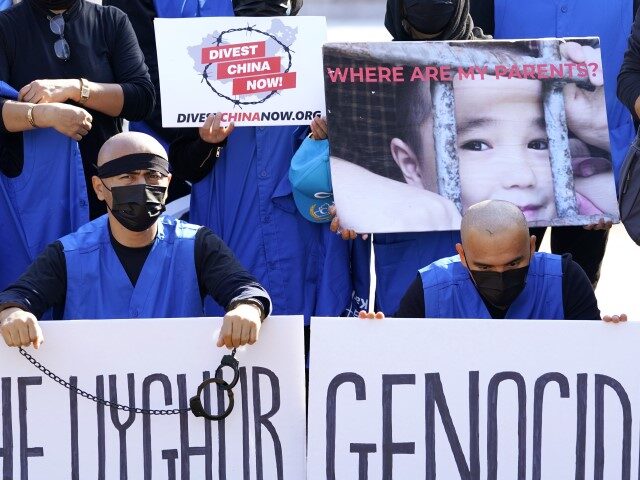A mountain of evidence including corporate documents, contractor websites, and photos of the work in question published on Tuesday indicates that a Volkswagen test track built in Turpan, East Turkistan, was constructed with the use of Uyghur slaves.
East Turkistan, a region west of China and north of Afghanistan, has been occupied by the Chinese Communist Party since 1949. China administers it as the “Xinjiang Uyghur Autonomous Region” (XUAR). Under current dictator Xi Jinping, the Communist Party began a campaign of genocide against the majority Uyghur population of the region and other Turkic minorities living there, fueled most overtly by the imprisonment of up to 3 million people in concentration camps and the mass sterilization of entire villages of women of childbearing age.
The genocide has included a slavery component. The Chinese government denies that it is engaging in genocide and refers to the concentration camps as “vocational and education training” facilities. Survivors of the camps are sent to engage in slave labor – anywhere from cotton fields in East Turkistan to tech factories all over the country – when they “graduate” from their “vocational and education training,” according to Beijing.
In reality, the concentration camp prisoners are sold online in “batches of 50 to 100” people to willing companies, a report by Sky News revealed in 2021.
A report published on Tuesday by the German newspaper Handelsblatt, in coordination with acclaimed human rights researcher Adrian Zenz, implicated Volkswagen in Uyghur slave labor through the construction of a test track for its cars built in conjunction with the Chinese car company SAIC. The track in Turpan was built by a regime-linked Chinese company between 2015 and 2019, Zenz explained, and its subsidiary, the slave-linked “Xinjiang Test Track Project.”
NEW evidence directly implicates Volkswagen in forced labor: The SAIC-VW test track in Turpan was built using transferred "Uyghur laborers" in military drill uniforms (see photo). The VW project subjected them to indoctrination, biometric data collection, assimilation &… pic.twitter.com/KtFVJVMZeH
— Adrian Zenz (@adrianzenz) February 14, 2024
“This entity not only employed transferred Uyghur laborers through so-called ‘poverty alleviation’ projects, but also actively participated in government work teams monitoring Uyghur families,” Zenz revealed, “in arranging and hosting assimilatory ‘ethnic unity’ activities, exhorting Uyghur children to diligently study Chinese [Mandarin], and in facilitating the transfer of Uyghur surplus laborers to state-arranged workplaces.”
The “surplus laborers” were slaves wearing military drill uniforms, as evidenced in photos appearing in Chinese regime propaganda advertising the test track’s construction. The China Railway Engineering Corporation (CREC), the parent company of the “Xinjiang Test Track Project,” published photos “showing Uyghur laborers employed by the project in their military drill uniforms together with the characteristic red flowers that are a typical feature of the most coercive labor transfers,” Zenz reported.

An SAIC Volkswagen plant is seen in the outskirts of Urumqi in northwestern China’s Xinjiang Uyghur Autonomous Region, Thursday, April 22, 2021. (Mark Schiefelbein/AP)
“CREC and Xinjiang Test Track Project (XTTP) reports state openly that the Xinjiang Test Track Project employed transferred Uyghur surplus laborers during the peak of the mass internments in 2017 and 2018,” Zenz added.
While the “Xinjiang Test Track Project” no longer exists, the organization in charge of the test track is also reportedly using “low-skilled labor that especially in Uyghur regions is routinely performed” by “surplus laborers,” or Uyghur slaves.
“Volkswagen-controlled entity not only in activities aiding state atrocities, but also in subjecting its own staff to forced labor, assimilation, surveillance and indoctrination,” Zenz concluded.
Volkswagen has maintained operations in East Turkistan for years and faced increasingly loud condemnations for apparently doing little to ensure that its operations do not enable the genocide or benefit from slave labor. In May, anti-communist protesters interrupted a Volkswagen shareholder meeting and threw cake at the chairman of the company in protest of its ties to “Xinjiang.”
Protesters throw cake at Volkswagen’s chairman during a shareholder meeting. The activists were protesting the carmaker’s controversial factory in northwestern China’s Xinjiang region.#EastTurkistan #Uyghurs #UyghurGenocide #UyghurMuslims #Stand4Uyghurs #China 🇳 #CCPChina pic.twitter.com/hilR6eIos2
— ئوت يۈرەك ALİMJAN (@AlimcanTurdi) May 10, 2023
The German company has refused to relocate, though reports on Tuesday suggested that, in the aftermath of the Handelsblatt report, it may be reconsidering.
Following the publication of the initial report, Handelsblatt updated that Volkswagen was “under massive pressure” to address the bombshell report. A spokesman for the company claimed on Tuesday that “various scenarios are currently being intensively examined,” not dismissing the possibility that the German company could sell its share of the joint project to its Chinese partner SAIC and withdraw from East Turkistan. Bloomberg similarly reported that Volkswagen is “reviewing its activities in Xinjiang.”
At least one German investment fund, Union Investment, described Volkswagen as “uninvestable,” potentially heralding an exodus of investors in the company so long as it is tied to Uyghur slave labor.
Uyghur advocacy groups have also continued their pressure on Volkswagen to stop participating in activities that enable genocide, The World Uyghur Congress issued a statement on Tuesday categorically calling for Volkswagen “to withdraw from East Turkistan.”
“This is the only possible way to guarantee that Volkswagen is not complicit with the state-imposed forced labour scheme of the Chinese government,” the organization asserted. “We urge Volkswagen to no longer turn a blind eye to the truth. It’s long overdue for transparent, sincere actions and a thorough review of corporate policies.”
“The recent revelations about Volkswagen’s involvement in Uyghur forced labour should serve as a turning-point for VW to finally exit East Turkistan,” the president of the organization, Dolkun Isa, said. “VW has long enough avoided responsibility for its complicity in the human rights abuses of Uyghurs.”

COMMENTS
Please let us know if you're having issues with commenting.